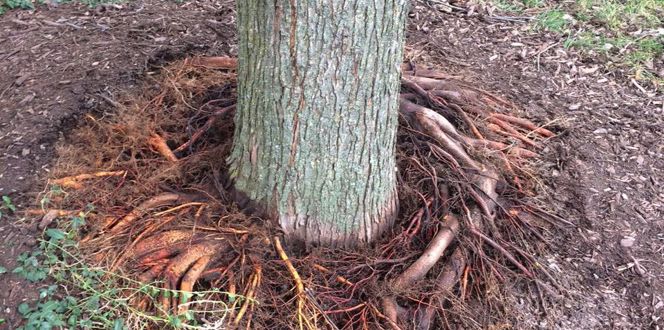There’s a lot to love about tree roots. They’re in charge of stowing away the nutrients trees need to stay healthy and anchoring trees in place so they can stand tall and proud.
But let’s face it: no matter how wonderful roots are, it sure is a pain when they creep up past the soil surface and start to grow above ground. Exposed tree roots aren’t just unappealing to look at, they make it tough to landscape your yard and leave your trees vulnerable to damage.
So, you’ve got exposed roots; now what? Read on to learn how surface roots can affect the health of your tree.
My tree roots are exposed. What do I do?
When you’re dealing with above-ground roots, protecting your tree from damage should be a top priority.
Do exposed tree roots cause damage to my tree?
Exposed tree roots in and of themselves don’t mean your tree’s in trouble. It’s quite the opposite, in fact—trees with surface roots are alive and well. We often think that tree roots are burrowed deep into the soil, and yes, they can stretch far underground. But some tree roots are shallower than we think, sitting just 10 inches or less below the soil. It’s not uncommon for these shallow roots to pop up above ground as the tree grows over time.
The real risk comes from surface roots being damaged by lawn mowers or other machinery. When exposed roots are wounded, the tree is more vulnerable to a disease or insect infestation. Plus, the healing process can take quite a long time, and trees need extra care to regain their strength.
Landscaping with exposed tree roots
When tree roots surface, the look and feel of your landscape can change.
For starters, mowing the lawn when you’ve got exposed roots can feel like navigating a maze. It’s crucial to avoid rolling over roots with your mower, so it might be tough to give your grass a uniform look.
Also, outdoor spaces could be compromised. You wouldn’t want to set up a seating or play area near exposed roots because they’re a tripping hazard.
And to some homeowners, surface roots just don’t look good. Luckily there are a number of ways you can cover above-ground roots to keep your yard appealing and your tree protected.
Best ways to cover up and protect exposed tree roots
If you don’t like the look of surface roots, cover ‘em up! Low maintenance, shade-loving ground cover plants will both camouflage the roots and add charm. Plants like periwinkle, Japanese spurge, Asiatic jasmine and wild ginger are all great options.
Also, protecting above-ground roots with mulch has dual benefits—you can shield the roots from damage and conserve moisture in the soil at the same time.





